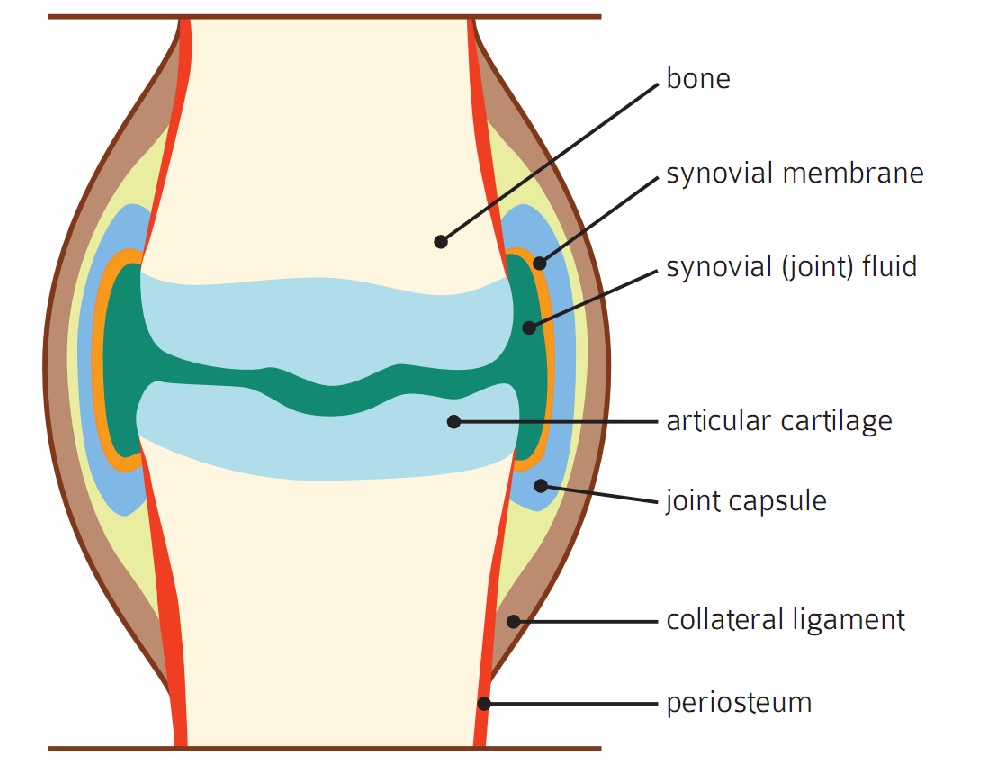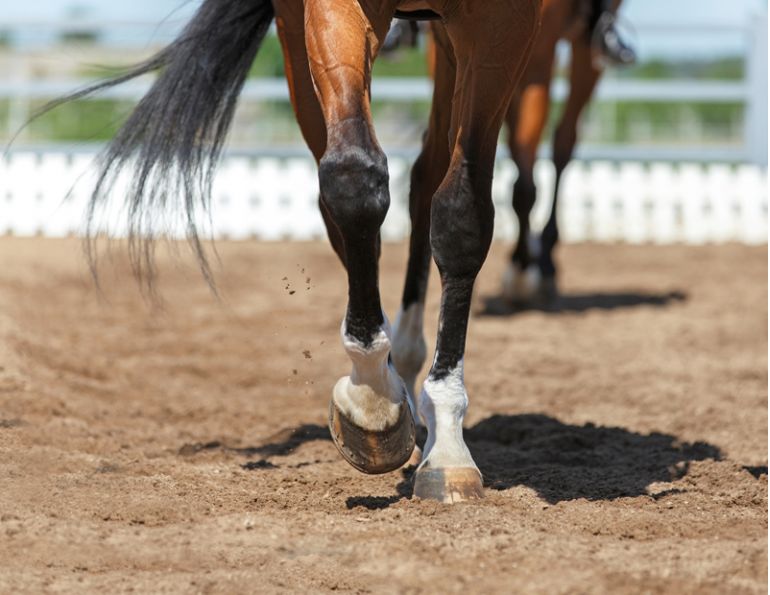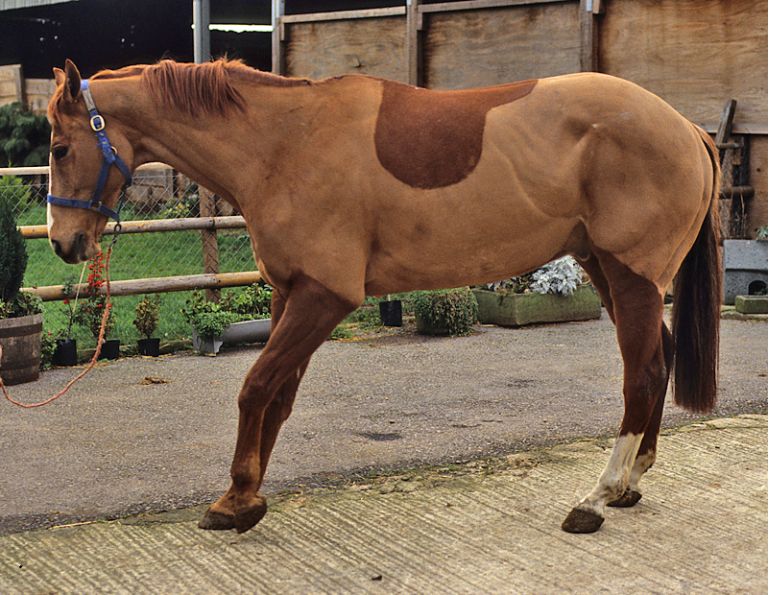By Mike Scott, DVM, MVSc
For many horse owners, much of the enjoyment and reward of the human-horse relationship comes from athletic pursuit. At almost any level of riding, the soundness of the horse is important. Any injury that reduces the horse’s soundness can affect athletic performance, reduce the enjoyment derived from exercise for both horse and rider, and cause chronic pain and suffering. Unfortunately, lameness is a relatively common problem affecting horses of all types and occupational uses, and one of the more common causes of lameness is joint disease.
What is Joint Disease?
The terms degenerative joint disease, arthritis, and osteoarthritis are used somewhat synonymously and have similar meaning. Degenerative joint disease is a more general term used to describe degenerative changes affecting a joint over a period of time. The literal meaning of arthritis is joint inflammation, while the term osteoarthritis can be defined as an inflammatory process affecting bone and joint.
A central theme in any discussion of joint disease is the concept of inflammation. The inflammatory process is initiated by traumatic injury, infection, degenerative processes, or “wear and tear” (chronic low-grade repetitive trauma). Once inflammation is initiated it may perpetuate itself, and the effects of this process can cause tissue damage leading to more inflammation. When tissue is injured, chemical messengers are released which cause increased blood flow to the region, increased permeability of blood vessels in the area, pain, and swelling. Once this inflammatory cascade is triggered, white blood cells and other blood products leave the circulation and concentrate in the region of injury, in this case the interior of the joint.

Joint pain is caused by inflammation of both the synovial membrane, and the joint capsule surrounding it. Inflammation in turn propagates further deterioration of the joint.
Joints normally contain a relatively thick viscous fluid called synovial fluid, which plays many important roles in the health of the joint including nourishing cartilage, waste elimination, hydrostatic stabilization, and lubrication. With inflammation, the volume of fluid within the joint will often increase, as protein and plasma from the circulation diffuses into the joint and is added to the synovial fluid. White blood cells then move into the joint, where they release damaging enzymes, free radicals, and pro-inflammatory chemical messengers.
It is important to realize that this process of inflammation is a large part of what damages the joint over time. The alteration of the normal internal environment of the joint, the changes in the synovial fluid and the cartilage, and the actions of the white blood cells lead to cumulative and potentially irreversible damage to the tissues of the joint. The synovial fluid becomes less viscous and nourishing, the cartilage loses its resiliency, the soft tissues lining and supporting the joint become thickened and stiff, and the bone beneath the cartilage becomes abnormal, sometimes even collapsing or changing shape. These processes result in impaired joint function and pain. So while traumatic injury or “wear and tear” may be involved in causing joint disease, it is the body’s own reaction to these injuries in the form of inflammation which can exacerbate or perpetuate the injury leading to chronic osteoarthritis. A fundamental concept in treating this problem is reducing this inflammatory response, and many of the treatment options currently used in equine veterinary medicine are used in pursuit of this goal.
Diagnosis
One of the more important steps in the treatment of joint disease is diagnosing the nature and location of the problem. This can be a straightforward problem such as in the case of a horse with an obviously swollen and painful fetlock joint, but it can be very challenging in cases where there may be multiple joints involved, mild lameness or poor performance issues, or complex lameness problems involving multiple structures. A thorough lameness examination should be performed in an attempt to make a diagnosis, so that informed and appropriate decisions can be made regarding treatment. While this seems logical, it is relatively common for horses to be treated with joint injections or other therapies without much effort made at diagnosis, which is not ideal and can lead to treatment failures or other problems. A lameness examination should include obtaining a detailed history of the horse and its problems, examination of the horse, and observation of the horse in motion. This is usually followed by some diagnostic testing, including anesthetic nerve blocks or joint blocks, radiography, ultrasonography, or possibly even advanced imaging techniques such as nuclear scintigraphy or magnetic resonance imaging (MRI). While diagnostic imaging or other tests may not be needed, a lameness examination provides the framework for planning treatment and assessing the response to treatment over time, which is important in treating joint disease as it can be a chronic or recurring problem.
Systemic Treatment
In treating the horse with joint disease, we have two basic objectives; to reduce the symptoms of the disease (particularly pain), and to decrease or stop the progression of the disease. While some treatments may just decrease the symptoms of joint disease, others can decrease disease progression particularly if they can reduce the severity of joint inflammation for a period of time. Reducing chronic joint inflammation can protect the tissues of the joint (especially the cartilage), thereby reducing the progression of osteoarthritis. Based on this concept, it makes sense to take a proactive approach to the management of equine joint disease.
Systemic treatment involves administration of medications to treat the “whole horse,” usually through oral, intramuscular, or intravenous routes. Advantages of systemic medication include the fact that multiple joints can be treated, that a specific diagnosis may not be necessary, and that prophylactic benefit may be obtained by treating the horse before joint disease develops.
Non-steroidal anti-inflammatory drugs (NSAIDS) are an important tool in the treatment of lameness and musculoskeletal injury, including joint disease. This class of medications, which includes phenylbutazone, flunixin, firocoxib, and others, act to inhibit steps in the cascade of enzymatic reactions leading to inflammation. The main benefit of these medications is to reduce the symptoms of joint disease, particularly pain and inflammation.
Hyaluronic acid (HA), also called hyaluronate, is another important medication used for treating joint disease that can have both symptom modifying and disease modifying effects. Hyaluronate is a naturally occurring molecule found throughout the body, particularly in cartilage and synovial fluid. High concentration of HA in synovial fluid is one of the things that give it viscosity. While our knowledge of its mode of action is incomplete, it appears that by giving HA to horses we signal cells within their joints to make more of their own HA (which is good for the health of the joint) and to reduce inflammation within the joint. Intravenous administration of HA has been shown to reduce joint inflammation and reduce the progression of joint degeneration in experimental models of equine joint disease. Additionally, there is evidence from prospective clinical trials in racehorses which has demonstrated improved performance, decreased injury, and longer racing careers in horses receiving intravenous HA prophylactically. Our current recommendation for prophylactic use is 40 milligrams intravenously once every two weeks.
Another class of naturally occurring, essential molecules found in cartilage is glycosaminoglycans. One of the hallmark features of early osteoarthritis is the depletion of glycosaminoglycans from cartilage. Polysulphated glycosaminoglycan is another systemic medication used for the treatment of equine joint disease.
Photo: Pam MacKenzie - Joint injections can reduce the pain associated with joint disease, as well as help slow the progression of the disease.
Local Treatment – Joint Injections
While systemic treatment is an important component in the prevention of joint disease and in managing affected horses, local treatment of arthritis joints provides a method for targeted, highly effective treatment. In many cases, systemic medication alone is not sufficient to alleviate the pain of joint disease, and joint injection is needed in order to have the best chance of returning the horse to full function for a period of time. There are numerous misconceptions or half-truths that exist within our horse culture with respect to joint injections, such as they are detrimental, they accelerate the degeneration of the joint, or that once you start treating a joint with injections you cannot stop. While the misapplication of joint injections may be detrimental, veterinary medicine has advanced to the point where our understanding of joint disease and the various medications used for joint injection can be used safely and effectively to both reduce the symptoms and decrease the progression of the disease. This is an important concept: in experimental models of arthritis, horses treated with joint injections with corticosteroids (triamcinolone) and hyaluronate developed less arthritis than those treated with a placebo. In other words, not only can joint injection reduce the pain of joint disease, it can help protect the joint against the damaging effects of inflammation, which can slow the progression of the disease.
Corticosteroids are an important group of medications, which have been and continue to be a mainstay in our options for treatment of joint disease. They are our most potent anti-inflammatory medications. There are different corticosteroid types used for joint injection, which differ in strength, time of onset, and duration of action. Not all are equal in their efficacy, and some may have detrimental side effects systemically and/or within the joint. Recent research examining the effects of triamcinolone has shown that this corticosteroid is particularly effective, and can have both symptomatic and protective benefits. The combined injection of corticosteroids and hyaluronate into arthritic joints seems to have a synergistic effect.
Local Treatment – Biologicals
Recent research and development in the treatment of equine joint disease has led to the addition of biologically-based treatments to our range of options. These biologic treatment options use tissue from the horse such as blood, serum, bone marrow, or other tissues in the development of novel therapies. While this is an active area of research in which we are still in the early stages, there have been some promising results.
Within the inflamed joint, a protein chemical messenger called interleukin-1 (IL-1) is one of the main signals for the propagation of inflammation. Another protein chemical messenger called interleukin-1 receptor antagonist (IRAP) acts to oppose the actions of IL-1 by blocking its cell surface receptor, which has a potent anti-inflammatory effect. By taking blood from the horse, incubating it for 24 hours, and processing it, we are able to make doses of equine serum with high levels of IRAP and other anti-inflammatory proteins, which can then be injected into joints. This new treatment option can be used in horses that respond poorly to cortisone injections, or as an alternative treatment option.
Over the last several years there has been a high level of interest in medical circles and the media regarding the use of stem cells for medical procedures. The general concept of a stem cell is a cell type which is relatively undifferentiated and which has the ability to divide and produce more cells of this type. These cells can then differentiate into more specialized or specific cell lines, such as muscle cells, cartilage cells, tendon cells, etc. We can obtain these cells from the tissues of the adult horse (primarily bone marrow), and grow them in the laboratory as tissue cultures. In theory, introduction of these cells in regions of injury could provide superior healing through tissue regeneration rather than tissue repair through scar tissue formation. While this is an appealing theory, at this point there is a lack of evidence to show that this is what actually happens. However, despite gaps in our knowledge, there are some promising experiments and clinical studies on the use of bone marrow derived stem cell cultures in the treatment of equine joint disease. These studies suggest that this treatment may modify the degenerative joint disease process and improve the health of the joint, although not in ways predicted by our theory of regeneration. It appears that these cultured cells may act to influence the overall cellular environment within the joint through inter-cell signaling mechanisms, reducing the cycle of inflammation and degeneration. While much is yet to be discovered about this type of treatment, it does show promise as an additional option for joint disease treatment in certain situations.
In our perpetual pursuit of higher, faster, stronger, it is important to recognize the price that our equine companions pay for our competitive aspirations. The harder we push for success, the greater the chance for injury. Responsible horse ownership should include recognizing the risk factors for injury, understanding the options and methods for reducing risk and dealing with injury, and taking action. Comprehensive prevention and management of joint disease in the equine athlete is affected by many factors; genetics, nutrition, training, fitness level, foot care, and veterinary care all play a role. By paying careful attention to all these factors, we can hope to reduce the impact of equine joint disease and have healthier, happier horses.
Mike Scott, DVM, MVSc, is a Diplomate of the American College of Veterinary Surgeons, and a Board Certified Specialist in Large Animal Surgery. His practice is based at Moore Equine Veterinary Centre Ltd. on the north edge of Calgary, Alberta. www.mooreequine.ca
Main article photo: Robin Duncan Photography - Chronic low-grade repetitive trauma, or "wear and tear," can lead to inflammation in the joints.
This article originally appeared in the April 2012 issue of Canadian Horse Journal.

























